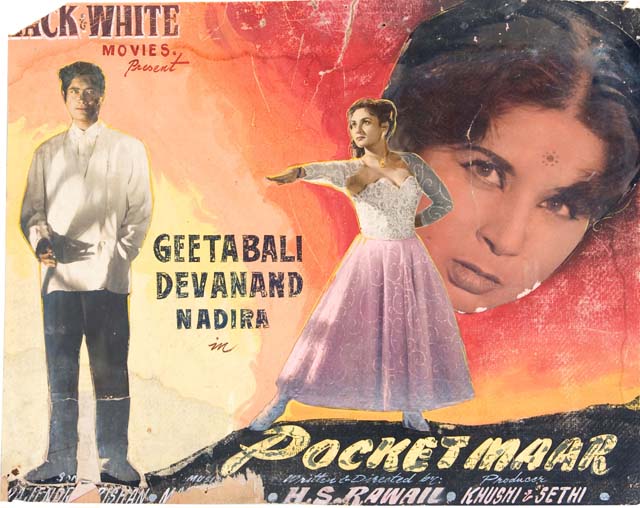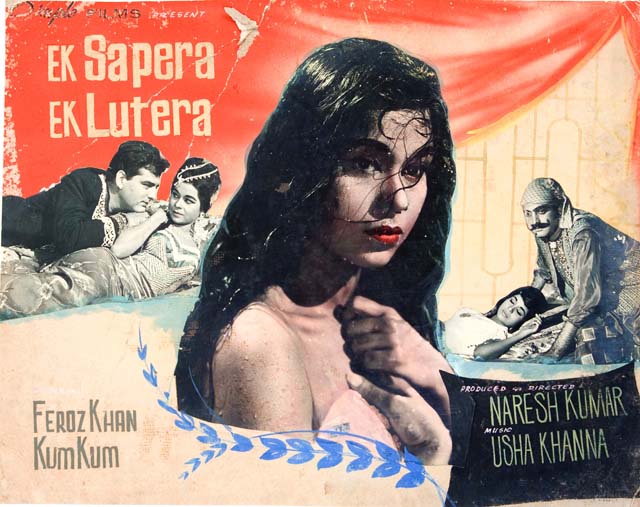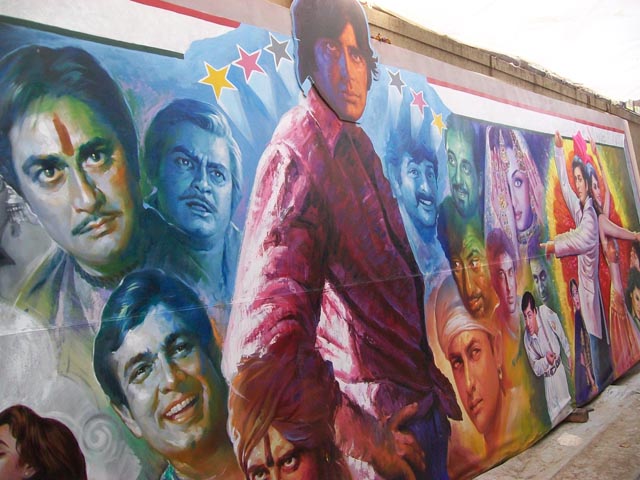Bollywood Showcards – Markers of Hindi Cinema’s Fantasy World
Long before Hindi cinema was rechristened Bollywood, there were film posters and showcards under glass in the lobbies of the theaters in India. As you bought your tickets to enter a magic world, you sauntered by the display cases to check out these show cards behind glass, a collage of hand painted photographs which whetted your appetite for the treat to come. Most of these old markers have disappeared but recently cinema fans got a chance to see a cache of vintage cards, lovingly preserved.
The Institute for Contemporary Culture (ICC) at the Royal Ontario Museum (ROM) presented the North American debut of Bollywood Cinema Showcards: Indian Film Art from the 1950s to the 1980s, in collaboration with the Hartwick Collection, in 2011.
Bollywood ‘s influence is certainly spreading worldwide, and it seems hard to believe that this form of cinema advertising churned out by unknown, unsung artists and forgotten over the years is getting so much respect – a true bonus for Hindi film fans.

Bollywood Cinema Showcards: Memento of Films Past
Bollywood Cinema Showcards: Indian Film Art from the 1950s to the 1980s features over 120 works of art, including 77 showcards from the private collection of Angela Hartwick and a selection of posters, lobby cards and film booklets from the ROM’s permanent collection. The installation traces the aesthetic and thematic evolution of Bollywood graphic design as seen in its advertising, from the years after India’s independence in 1947 through the liberalization of India’s economic policies in the early 1990s. These showcards were generally associated with Hindi commercial cinema but with newer forms of advertising have all but disappeared. “They were originally produced by local artists but usually thrown out at the end of a film’s run,” says Dr. Deepali Dewan, ROM Curator of South Asian Arts & Culture. “It is remarkable that this collection has survived at all.”
Also on view was Embellished Reality: Indian Painted Photographs from the 1880s to the 1940s which showcased 75 works from ROM’s permanent collection, photographic portraits almost completely covered with paint as a way to enhance the subject. By combining the art of painting with the technique of photography, these artists created a distinctive genre of Indian visual culture. These works are a precursor to Bollywood showcards, as the concept of enhanced photographs and embellished realities complements the fantasy world created by Bollywood cinema. Together with Bollywood Cinema Showcards, these two exhibitions presented a 100-year survey of Indian visual culture related to the Indian photography and film industry.

Bollywood Showcards: A chat with Deepali Dewan, Curator, South Asian Arts.
Lassi with Lavina: Tell us about the history of Bollywood showcards. Are they still produced & are the methods the same?
Deepali Dewan: The showcards were one among different types of advertising made for the Bombay commercial cinema industry. They were film still photo-collages that were hand-tinted and hand-painted, and displayed inside glass cases at the entrance of theatres or in the lobby area. While billboards and posters were part of the film advertising package in the West as well, showcards seem to be uniquely South Asian. It is unclear when they started being produced, but by the 1980s they had declined in production, often associated only with low budget movies. By the 1990s, with the import of digital technology into India, the hand-crafted showcards were replaced by digitally printed ones that had been designed on the computer. In this form they are still produced today.
Lassi with Lavina: Do you yourself remember seeing Bollywood showcards in India and which are your favorites?
Deepali Dewan: I never saw movies in India until I was an adult. While I spent the early years of my youth in India (and remember adult relatives going to the movies or watching them on TV), I grew up in North America as my parents were amongst the many families in the Indian Diaspora who migrated in the 1970s.

Lassi with Lavina: Is there any value attached to Bollywood showcards?
Deepali Dewan: If you mean monetary “value”, they are not so expensive on the art market, although through the efforts of auction houses like Osians in Mumbai, these types of vintage Bollywood advertisements are getting more attention and collectors are starting to buy them. If you mean emotional “value”, they are hugely attractive to a wide Indian population who have a strong sense of nostalgia when seeing the vintage showcards. They are a connection to a place and culture that is rapidly changing in today’s world.
Lassi with Lavina: How did Angela Hartwick come to collect these?
Deepali Dewan: When Angela Hartwick and her husband lived in the Middle East, they often came to India to work with clients (he does industrial photography and she is a producer). Angela is a collector and got very interested in Bollywood memorabilia. Over the years she amassed a large collection of showcards from a store in Mumbai’s Chor Bazaar. She has an eye for such popular art.
Lassi with Lavina: What does this say about Bollywood’s popularity that these cards which were generally thrown out have been showcased at ROM?
Deepali Dewan: The status of Bollywood has changed a lot in the last decade. While it has always had a degree of interaction with the international film industry, this has increased exponentially in the last decade after India went through drastic policy reforms and became part of the global economy.
At the same time, Bollywood ephemera, previously thrown out, has received increasing attention as an “art” form, entering into the global art market at exactly the same time studios of billboard painters have closed and been replaced by digital printing technology. The exhibition at the ROM both reflects and is a product of this shifting tide. It certainly reflects that Bollywood is more a part of global consciousness than ever before. It also reflects the increasing visibility of the South Asian Diaspora in Canada and how it has become a part of the Canadian cultural fabric.
(Updated in November 2013.)
What are your memories of Indian cinema? Do you collect Bollywood posters ? Did you ever see these showcards?
Please share!
.


2 Comments
Thanks Mari for your comment – these really convey all the drama of the old movies, being hand-painted photographs. In this digital age, this is a lost art.
Great showcards! They are packed with emotion and are very sensual. Definitely would encourage me to see the movie. Would be fun to collect these.